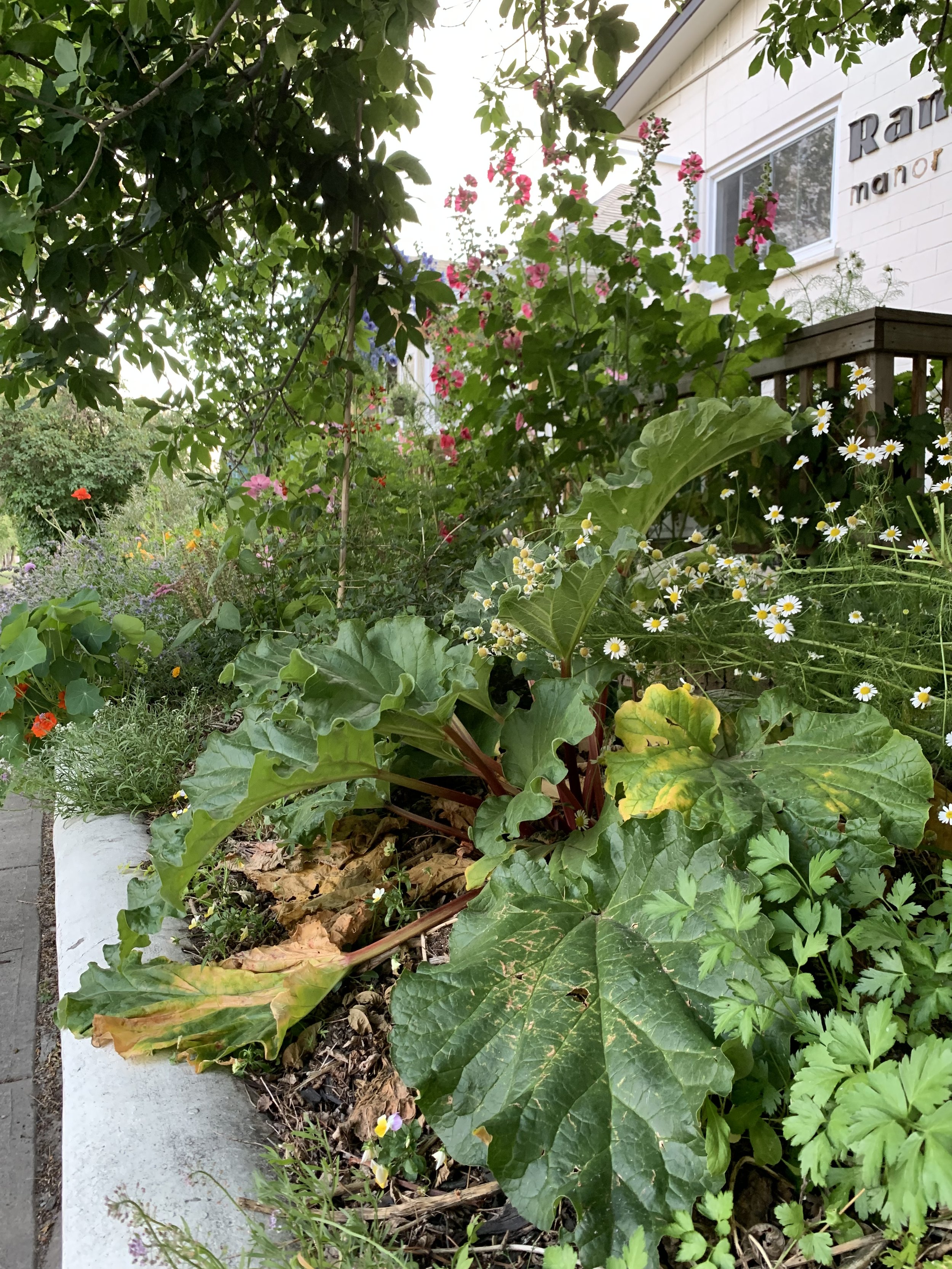Inspiration for Hawthorn
One of the original seeds for building Hawthorn Eco Retreat was planted when Nic and I took our permaculture course. Permaculture isn’t just about gardening — it’s a system for living. It’s about designing systems that mimic nature’s intelligence, creating reciprocity in our ways of living. We started experimenting in our inner-city Calgary home: re-routing downspouts into two 1000L IBC totes to harvest rainwater, converting xeriscaped lawns and astroturf into vibrant food forests with fruit trees, pollinator flowers, ground covers, and climbing vines. We wanted wild beauty and productivity, curb appeal and ecosystem health and being more connected to the community. Most of all, we wanted to build back a relationship with the land— to welcome biodiversity: birds, bees, and beneficial bugs back into the land.
When we started traveling again, we were drawn to places that held that same intention: sustainability, creativity, reverence for nature, and a sense of place. Here are a few that left a mark on us and shaped our vision for Hawthorn.
Big Island, Hawaii · Small Off-Grid Avocado Farm
We stayed in a small off-grid cottage tucked into an avocado farm on the slopes of Hawaiʻi. Everything ran on solar. Wastewater was processed on-site. Our shower used harvested rainwater. The toilet was compost-based, using wood shavings instead of water. There was something powerful about participating in that cycle — even our poop was a contribution 🙂. Each morning we foraged fresh citrus for juice, made guacamole from avocados plucked off the tree, and snacked on bananas warmed by the sun.
The host didn’t just rent out a space — he shared a relationship with the land. He talked about the farm’s history, walked us through the systems, invited us to participate. It was more than a stay; it was a way of life. Agricultural tourism, he called it. The cherry on top? A sunset ocean view that reminded us of why this kind of living is worth protecting.
What we learned from this:
Rainwater and solar systems really can work beautifully — with a bit of effort.
Composting toilets can be elegant and approachable.
Let the land feed the guest — literally and spiritually.
Tulum, Mexico · Jungle Brunch Experience
In the heart of the jungle, we joined a brunch experience that started with the words: “Here is your medicine.” by the host. Nic was moved to cry. The medicine was a bowl of food, grown right there on the land — and it truly felt healing. Relational. Reciprocal.
The host guided us through his 2.5-acre sanctuary: solar panels on every roof, three rustic homes, pigs and ducks, pathways lined with mango, pineapple, and cotton. Composting toilets. Shared kitchens and unique airbnb experiences. He plans to build a yoga and nap retreat space next. It felt like a place where every element had been thought through, every inch of land was in relationship with its steward.
What we learned from this:
2.5 acres holds so much — community, abundance, creativity.
It’s not just about the infrastructure. It’s about the relationship with the land.
Communal kitchens and shared space build connection.
Natural building materials like palapas are beautiful, breathable, and functional - though this doesn't always translate to cold climates.
Outdoor spaces (like tree-integrated showers and boardwalks) can be artful and alive.
Radium, BC · Radius Retreat
Back home in Canada, we visited Radius Retreat to see how sustainable off-grid living might look in a temperate climate more like our own. We stayed in a yurt called The Roost, a 400m hike from the car, nestled in a meadow with valley views. It was impeccably clean, with a cozy wood stove and recycled plastic deck chairs. We loved the composting toilet — not just a bucket, but part of a full-cycle vermiculture system on site. Vermiculture, also known as worm composting, uses worms to break down organic waste into nutrient-rich compost. It’s a natural, low-energy way to process waste while enriching the soil — a closed-loop system that felt aligned with the retreat’s deeper values. Paths were clearly marked, the outdoor shower tapped into a creek, and there were little surprises like a manmade waterfall and fire pits with seating carved into the land.
What we learned from this:
Small details (like clean paths, cozy interiors, or well-designed toilets) make a big difference.
Outdoor kitchens, showers, and common spaces are rich opportunities.
Letting nature take centre stage is enough. Add twinkle lights, a bookshelf, and some art — and you’ve got magic.
Screens are essential in buggy climates.
Synthesis · What We’re Dreaming Into Hawthorn
Each of these places — Hawaii, Tulum, Radius — added something to our toolkit. Some offered systems to replicate (solar, compost toilets, food forests). Others gave us emotional blueprints — reminders that land isn’t just where we stay, it’s who we’re in relationship with.
At Hawthorn, we want to:
Honour the land through both function and feeling
Build with natural, local, low-impact materials
Integrate food and foraging into the guest experience
Prioritize shared space that invites conversation and care
Design low-effort, low-impact systems that support a comfortable stay (like rainwater-fed showers, composting toilets, or solar lighting)
We’re not just designing cabins. We’re designing a rhythm — one that invites people to slow down, reconnect, and return to something essential.







